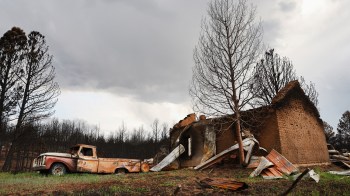Cell phone dead zones bring a call for more towers
On the afternoon of May 20, 2014, travelers driving through Oak Creek Canyon on their way to Sedona’s famous red rocks noticed a plume of smoke. Since they couldn’t get a cell signal, they followed the windy road until they reached the fire station 10 minutes away.
“I was very, very worried,” says lodge owner Mary Garland. “I just thought this fire was moving so fast. I really thought the lodge was going to be burned.” Garland watched the blaze devour hundreds of trees and come right up to her property line. First responders actually kept the flames from reaching the lodge and all of the other homes and businesses in the canyon, but the blaze burned 21,000 acres of the canyon.
“Minutes are crucial,” Sedona Fire Chief Kris Kazian says. “Seconds are crucial. Quick access makes the difference in our business.”
Residents say the fire could have been extinguished much sooner had there been a cell phone signal. “Cell phone service is the key to living in modern society,” says canyon resident John David Herman.
He worries about all of the potential emergencies that could happen in a 12-mile-long cell phone dead zone. “You drove here,” Herman says. “You could’ve had a flat tire. You could’ve gone off in the road. A million things could’ve happened, and you’d still be there.”
There are hundreds of places around the country like Oak Creek Canyon. If you look at a map of a cell phone provider’s service, there are large swaths of the country that have no cell signal.
The solution seems simple: Erect more cell towers. But Verizon and AT&T say the rugged terrain in Oak Creek Canyon makes that too difficult. Sprint says erecting towers in places with few people is just too expensive. The cost to install a cell phone tower is about $25,000, and that’s not including the necessary permits.
“None of the carriers are going to do what we want them to do for the sake of 50 families in this community,” Herman says.
But carriers might put in cell towers for the thousands of travelers who drive through the popular canyon every day, says Mike Keeling, a cell phone engineer turned lawyer. “That traffic is a determiner for the operators of cellular companies as to where they put their towers,” Keeling says.
A long, unpopulated stretch of highway between Phoenix and Las Vegas, for example, has cell towers because it is heavily traveled by the subscribers, he says.
“If there were lots of folks there, then the return on investment would be available for a Verizon, or AT&T or Sprint,” Keeling says.
The federal government is working on a $7 billion program called First Net, which would put all first responders on the same cellular frequency and cell towers in those dead zones. But that program is still in its design phase.
For now, Fire Chief Kris Kazian is making do with an old emergency siren.
“Just a siren that notifies you,” Kazian says. “There’s no voice and there’s no means to tell you what to do once that siren’s activated. Everyone just run and panic.”
People often come to Oak Creek Canyon to get away from technology like cell phones. But as John David Herman says, it sure would be nice to have the option of turning that cell phone on to dial 911.
There’s a lot happening in the world. Through it all, Marketplace is here for you.
You rely on Marketplace to break down the world’s events and tell you how it affects you in a fact-based, approachable way. We rely on your financial support to keep making that possible.
Your donation today powers the independent journalism that you rely on. For just $5/month, you can help sustain Marketplace so we can keep reporting on the things that matter to you.


















